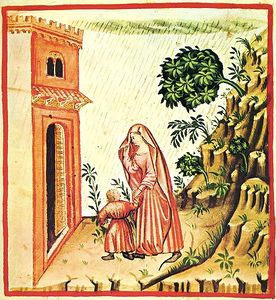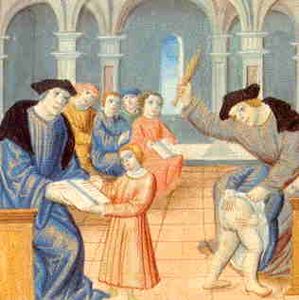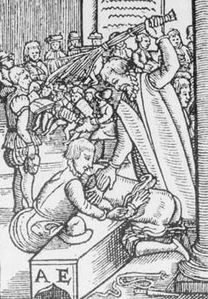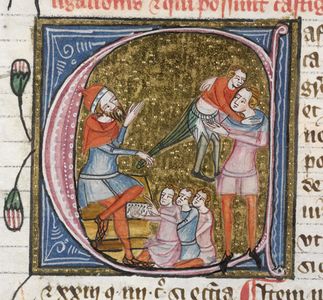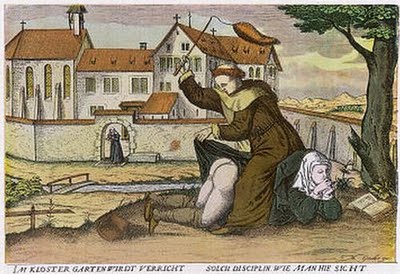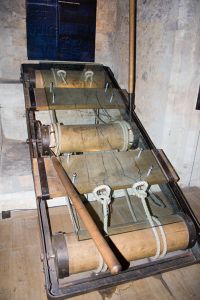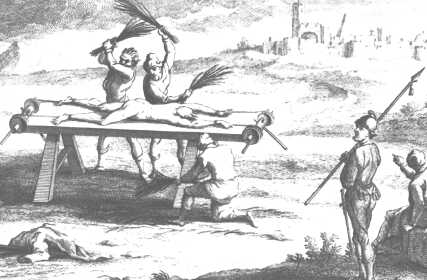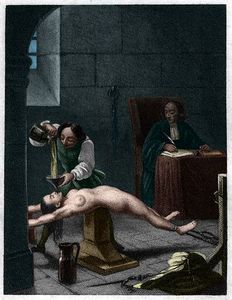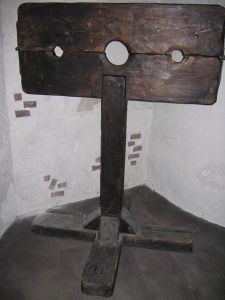Middle Ages
The Middle Ages or mediaeval period is generally regarded as beginning the time from the collapse of the Western Roman Empire in the 5th century. The end of the middle ages is much harder to define, with a variety of dates of significant events such as the Renaissance, the Protestant Reformation, the Battle of Bosworth Field (1485) or the Battle of Lepanto in 1571 being used in different places and fields of art and study.
Often in British thinking this broader period is divided by the coming of William the Conquerer in 1066, when the Anglo-Saxon age ends. Often the term Middle Ages is used to refer to this period of 1066 to 1485.
During the middle ages, society was often structured on a feudal basis, with a strict hierarchy of belonging and ownership, with many people tied to the land they lived and the masters they served.
The middle ages are often romanticised as the time of kings and knights, courtly ladies and monks and abbots. It is a mixture of the romantisization and the broader use of corporal punishment than in later times that makes the middles ages an attractive fantasy setting for corporal punishment scenarios.
Judicial corporal punishment in the Middle Ages
Life in the Middle Ages is often described as "nasty, brutish and short", and the punishments in use at the time bear out this description. In addition to execution, amputation, branding or burning, the stocks, the pillory and whippings were also used. Imprisonment was far less used as a punishment than in more modern times.
Floggings were frequently public, and frequently imposed. By a thirteenth century English law, all towns and villages were required to have a set of stocks and a whipping post set up and ready for use. Men, women and children were all sentenced to time in the stocks or at the whipping post.
Domestic and school corporal punishment in the Middle Ages
The large quantity of judicial corporal punishment carried itself over into the domestic and scholastic environment. Parents were expected to whip their children if they disobeyed, and by the late Middle Ages, the birch rod was the symbol of a schoolmaster.
Wives were also at this time considered to be totally subject to their husband, who could beat them as he could their children and servants. It was considered acceptable in many cases for a master to have his servant whipped, and at times Peasant status within the feudal system could be little better than slavery.
Medieval woodcut (1592) showing a school birching over a block.
The Church and the Inquisition
The Church was throughout the entire Middle Ages both the guardian and transmitter of learning and culture, and used corporal punishment as part of its means of transmission. Within religious institutions such as monasteries and convents, the lash was used as a means of maintaining discipline and self-mortification. By means of the use of both public and private penance, moral standards were enforced. As the principal source of schooling and education religious houses, and the monks that taught in them, were frequent users of corporal punishment.
During this time the dreaded Spanish Inquisition, created by the Church in 1478 to weed out and execute suspected witches, had virtually unlimited power. Anyone accused of witchcraft or consorting with the Devil could be seized and subjected to a variety of horrific tortures in order to obtain a confession. Refusing to confess led to certain execution, usually by being burned at the stake.
The high time of the horrors of the Inquisition was actually after the Middle Ages, in the 16th and 17th century.
Illustration of a birching rack from Spain or Italy, possibly the Spanish Inquisition (circa 16th century).
See also [ Converso ]
Influence on fetish films
Starting in the early 1970s, a new genre of sexploitation films called "nunsploitation" emerged which depicted the fetishistic side of religious cruelty within convents and inflicted on the public through the Inquisition. These films, many set in the Middle Ages, are rife with scenes of sadistic whippings, diabolical tortures, and perverse sex.
The next phase began in the late 1980s when producers of spanking and BDSM videos further eroticized the punishments and torture dungeons of this era in a number of period-piece films. London Enterprises released Witchfinder (1989) and Tower of Lyndon (1994). B&D Pleasures put out Medieval Dungeon Masters (1994) and released The Inquisition (2002) through their Bon-Vue Enterprises division. Lupus Pictures also set The Master Executioner in a realistic medieval dungeon and filmed The Warlock's Revenge in an actual 13th century castle using its dungeon, courtyard, and an ancient looking birching horse. The devil is literally beat out of a serf girl in Pain4fem's Painful Exorcism. The historical videos from House of Milan include Prisoners of the Inquisition, Dungeon of the Borgias, No Mercy for the Witches, Terrors of the Inquisition, and The Legend of The Torturer.
Another company, Inquisition World, is entirely devoted to making historical torture chamber videos, mostly set in the Middle Ages. They also produce torture-based videos from more recent fascist regimes such as Nazi Germany.
See also
- Abelard and Helo∩se
- Mortification of the flesh
- Internet History Sourcebooks Project
- Women in Prison films ("Nunsploitation" section)
- Wikipedia article: Middle Ages
Chat rooms • What links here • Copyright info • Contact information • Category:Root
